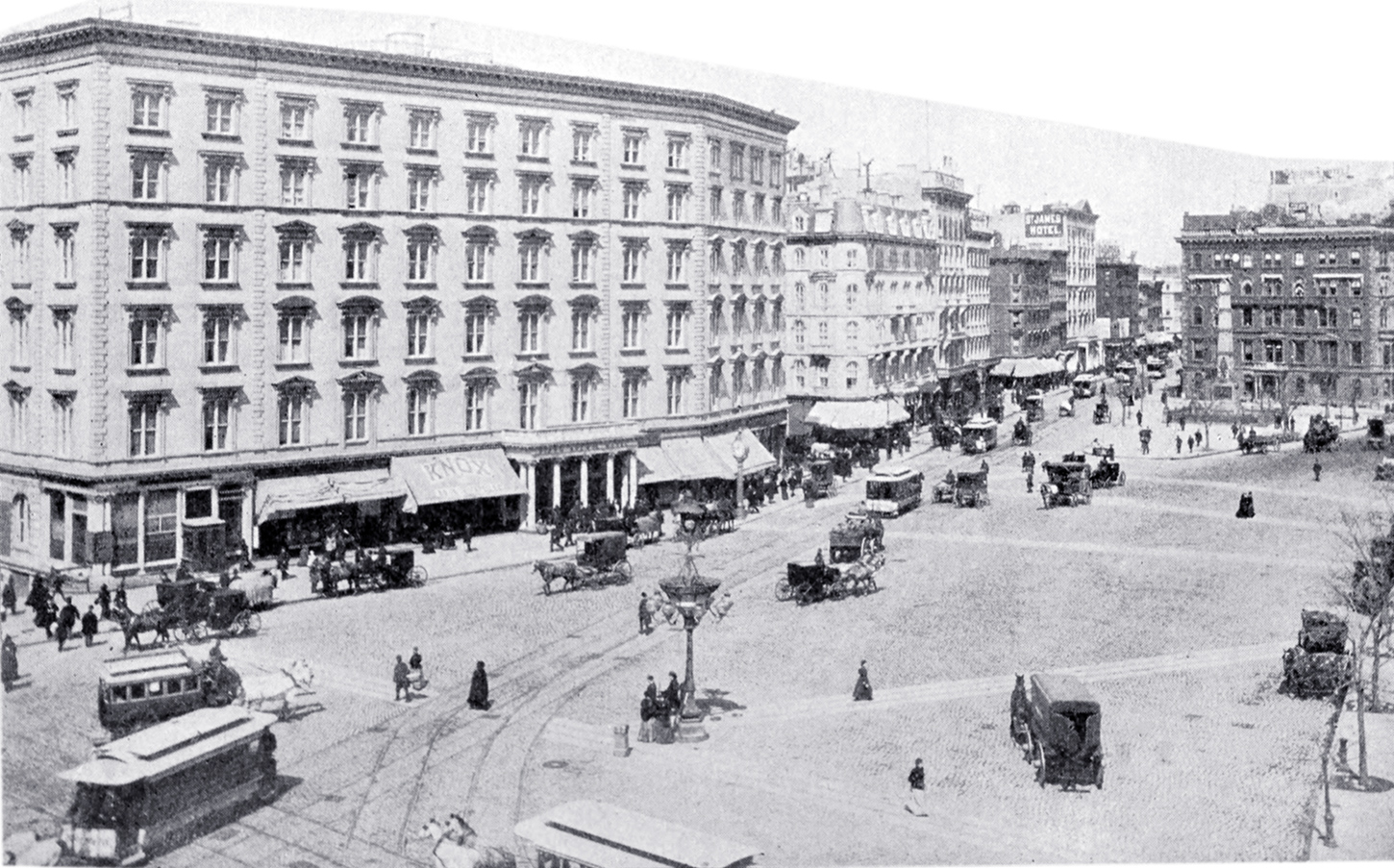
Junction of Fifth Avenue and Broadway at Madison Square - 1892 / 1893
These two photos (right and below) were published in the King's Handbook of New York City by Moses King, 1893 (Preface signed on July 1st) and complement each other. The photo below was also published in the King's Handbook, 1892 (Preface signed on September 1st).
The photos show the junction of Fifth Avenue and Broadway at Madison Square, between West 23rd Street and West 27th Street, and four hotels stand out (photo below): The Fifth Avenue Hotel, opened in 1859 and was demolished in 1908. The Albemarle, on the corner of 24th Street (opened in 1860). The Hoffman House (opened in 1864) and annex on the corner of 25th Street and St. James Hotel (built in 1857), on the corner of 26th Street. The Worth Monument, dedicated in 1857, and the old Worth House behind it, are on the right.
The following text accompanies the photo on the right:
«The Second National Bank occupies one of the busiest, most frequented, and most conspicuous corners in New York. It is at the intersection of Broadway, Fifth Avenue and 23d Street. At this point, the southwestern comer of Madison Square, the business life and the social life of the metropolis meet. Forty years ago the site was occupied by a roadside hostelry, which, when the steady northward march of improvement reached 23d Street, gave place to the Fifth-Avenue Hotel building. In 1863 the Second National Bank was organized and took possession of its present suite of offices, and there it has since remained. The original capital of $300,000 remains unchanged, a surplus of 450,000 having accumulated in addition. On December 31, 1875, an extra dividend of 100 per cent. was declared, and paid to the stockholders. The first president of the institution, Henry A. Hurlbut, is still a member of the Board of Directors. George Montague, its President since 1884, is one of the well-known and experienced bankers of New York...»

Original title: "Second National Bank, 23d Street, Fifth Avenue and Broadway, in Fifth-Avenue Hotel" (on the right). Photo shows West 23rd St., looking west from Madison Square at Broadway. Flatiron Building was erected on the site seen in the lower left, from 1901 to 1902.

According to the King's Handbook (1893), "The Fifth-Avenue Hotel (American plan) has borne a conspicuous part in the public life of the metropolis, and has been identified with the most notable local events of the generation, since its opening, in 1859. Both location and management have contributed to this prosperity. The house fronts upon Madison Square, the most charming of the smaller parks of the city, at the junction of Broadway and Fifth Avenue, the two great thoroughfares. It is unequalled in the number and spaciousness of its corridors, halls and public rooms, and the commodious character of its guest-rooms. The proprietors are Hitchcock, Darling & Co."
"The Albemarle (European plan), on Madison Square, at the junction of Broadway and Fifth Avenue and 24th Street, is a quiet and exclusive place, numbering among its guests many permanent residents and foreigners of distinction."
"The Hoffman House (European plan) is famous the world over for its magnificent banquet-hall and its art-gallery, no less than for its cuisine and its general excellence as a hotel. It is on Broadway, between 24th and 25th Streets, and its front takes up nearly the whole block. It has a sightly and beautiful location. The Broadway front of the house dates from 1864 ; and the eight-story fire-proof annex on 25th Street was erected in 1882-85, in Italian Renaissance architecture. The great Banquet Hall of the Hoffman is 60 feet square, with beautiful allegorical paintings. The bar-room contains Bouguereau's painting, "Nymphs and Satyr," Correggio's "Narcissus," Chelmonski's "Russian Mail Carrier," and other priceless paintings and sculptures."

Original title: "Madison Square, Showing Fifth-Avenue, Albemarle, Hoffman and St. James Hotels" (1892).
Junction of Fifth Avenue and Broadway at Madison Square - 1892 / 1893
|
Copyright © Geographic Guide - Historic Places of Old NYC, 19th century. |